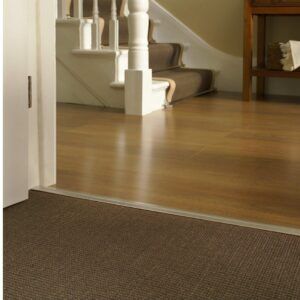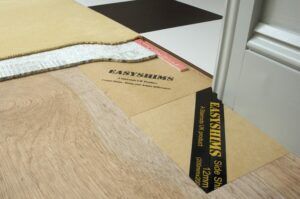The choice of floor edging on the market is extensive and the terminology can be confusing at times. For instance it is also commonly referred to as flooring trims or door thresholds, transition strip and carpet bars, to name but a few. So, here are five key questions you need to consider before deciding on which floor edging to buy is right for your project.
Floor edging is typically used where floorcoverings are joined together. The most common place is in a doorway, such as where a room joins onto a landing or hall. It is also useful in an open-plan layout where your flooring changes in style, such as ceramic tiles in a kitchen adjoining a breakfast or dining room. Floor edging is also very handy to create mat wells or for an inset rug.
1. What type of flooring are you joining?
The type of flooring will determine the floor edging you require. The most common ones tend to fall into the following categories: carpet, vinyl, wood, laminate, LVT, ceramic/porcelain tiles.
If you have a carpet, it is best to know if it is fitted over underlay e.g. a tufted or Axminster carpet or stuck down to the floor or underlay e.g. cheap cord carpet.
Natural flooring e.g. sisal, seagrass or coir tends to be stuck to an underlay, although some are stuck to the base floor.
Hard flooring is a term which has come to include wood, stone, laminate, ceramic/porcelain tiles, rubber. Basically, anything which does not compress when you step on it.
Vinyl: this includes sheet, self-adhesive tiles, planks and luxury vinyl.
The sub group of hard flooring includes wood, engineered wood or laminate. An important question you need to ask is if your flooring is floating i.e. will it expand and contract with atmospheric conditions, such as moisture levels, in the house? You need to be sure that any flooring trim or edging allows this to happen naturally i.e does not constrain the natural movement of the floor. If not, you may find your floor buckles when it expands.

2. Do you have underfloor heating in the area where your edging is to be fitted?
If in doubt, make sure you avoid fixing your door thresholds with nails and instead use an industrial adhesive to stick to the base floor. For example the carpet to carpet door thresholds can be nailed or stuck in place, whilst there a number of no screw options which stick in place for hard flooring.
3. Is the finished height of your two floorcoverings level or is there a step between the two?
If the difference is just 1 -2mm then it is common to lift up one side of your chosen door threshold, to bring the two floor coverings level with each other. We supply Easychocks free of charge to facilitate this. Anything above 2mm and you need to consider some sort of a ramp to cater for the level difference. This could be a cover plate which can simply be fitted at a slight tilt or a threshold with an in-built ramp such as the Compressions Ramps (use with carpet), 2 Way Ramps or Premier Ramps (use with hard flooring). The Easyshim from Stairrods (UK) is an ingenious invention which creates a ramp under a carpet.

4. What is the floor edging made of?
Your flooring fitter will typically have on his van a selection of silver or gold aluminium strips which are easy to fit. Normally made of thin gauge metal, they can quickly and easily dent or buckle with foot traffic or regular use of a vacuum cleaner. Many people spend hundreds, if not thousands of pounds, on their new floor only to rip out the poor quality door thresholds and trims in order to retro fitter better quality ones.
Quality floor edging is designed to last for years and look smart. Our ranges are made from solid brass or a thick-gauge aluminium, which are designed to withstand cleaning equipment, foot traffic, toys and wheelchairs.

5. What finish do you want?
A few options to consider before you choose are:
- Do you want your floor edging to be unobtrusive, in which case choose a finish to complement your floor covering?
- Do you want them to match throughout the house?
- Do you want them to match other fittings in the room e.g. light fittings, door furniture?
- Do you want them to age naturally? If so, check the manufacturer’s details. Our polished, antique and satin brass and antique bronze floor edging will oxidise naturally, which is the popular option with most customers. Other finishes, including mirror chrome, brushed chrome, black and pewter will remain consistent in finish.
- High quality, heavy gauge aluminium floor edging in a polished or satin effect is also a good alternative, especially if you are looking for a more contemporary feel. Our AL range has an amazing finish.
Armed with the answers to the 5 questions above, you are ready to choose the appropriate floor edging for your project. And, if you have a fitter involved, at least you can tell him what you want and hopefully avoid being disappointed.
We offer online the full range of Floor Edging and Trims and deliver to your door. Choose which you would like and pay securely online. Any questions, please just give us a ring T: 0330 113 4909

 0330 113 4909
0330 113 4909